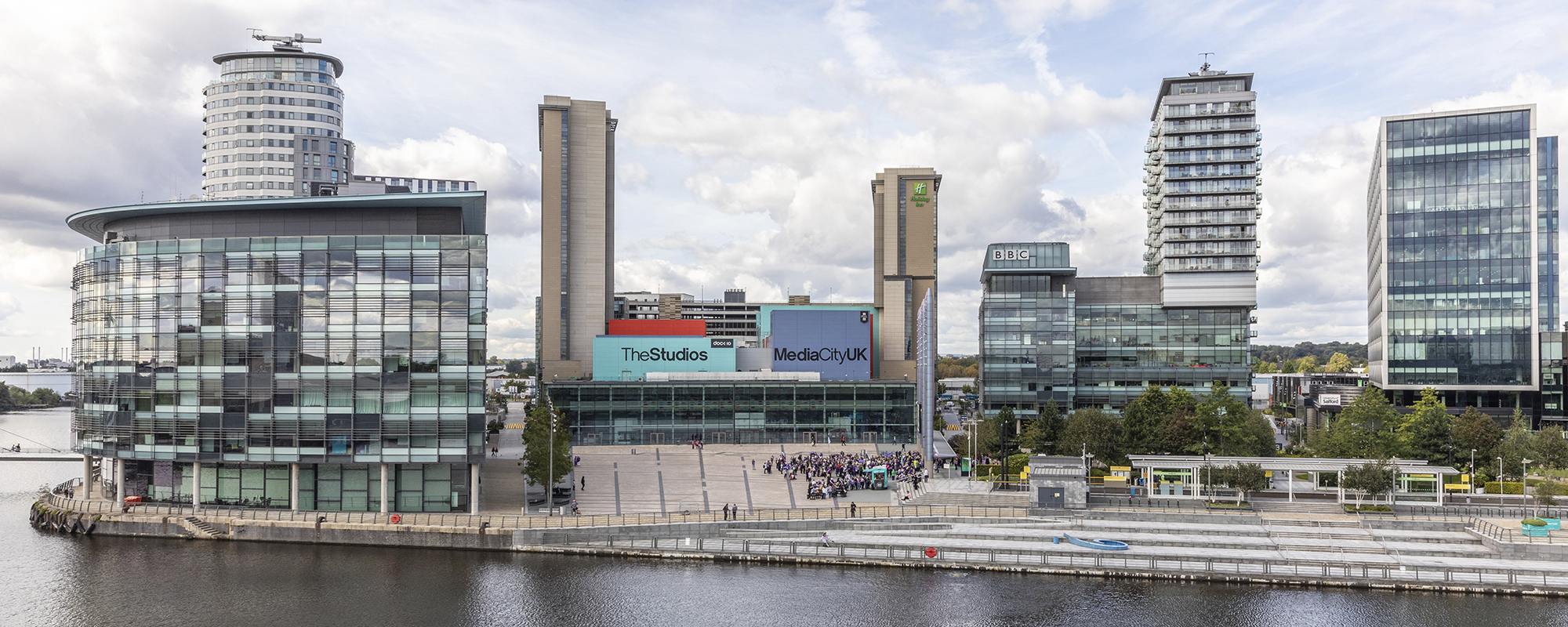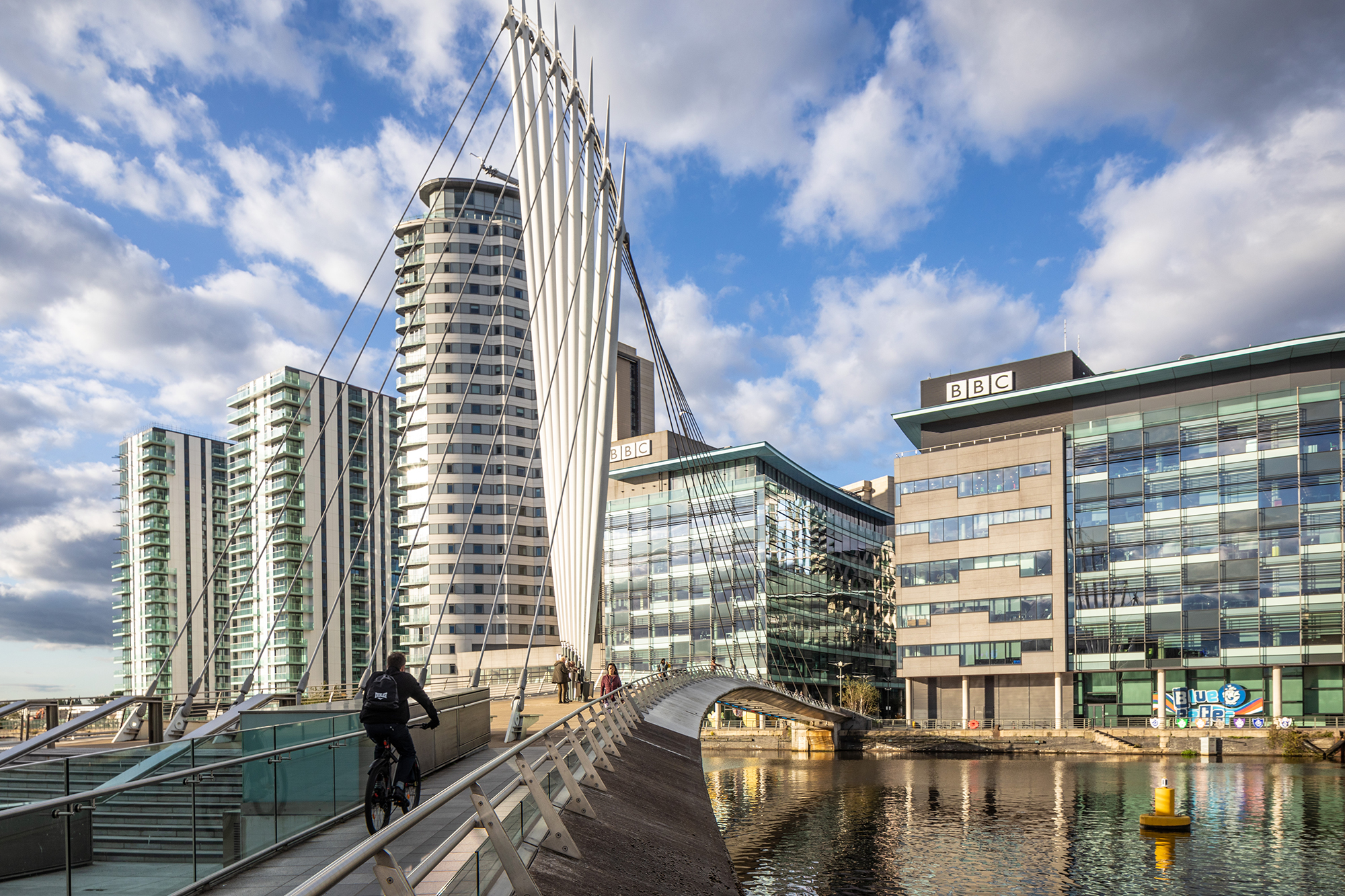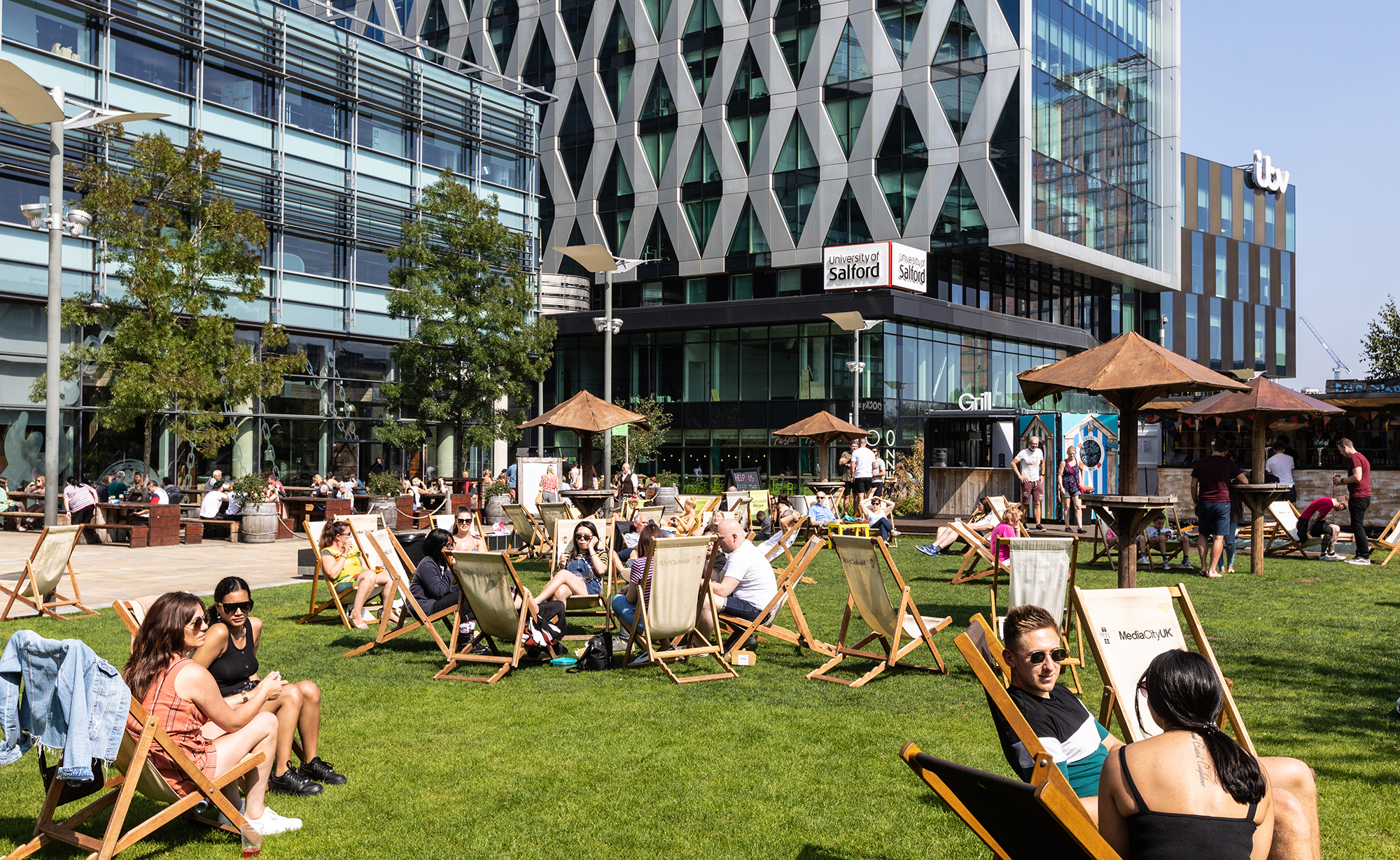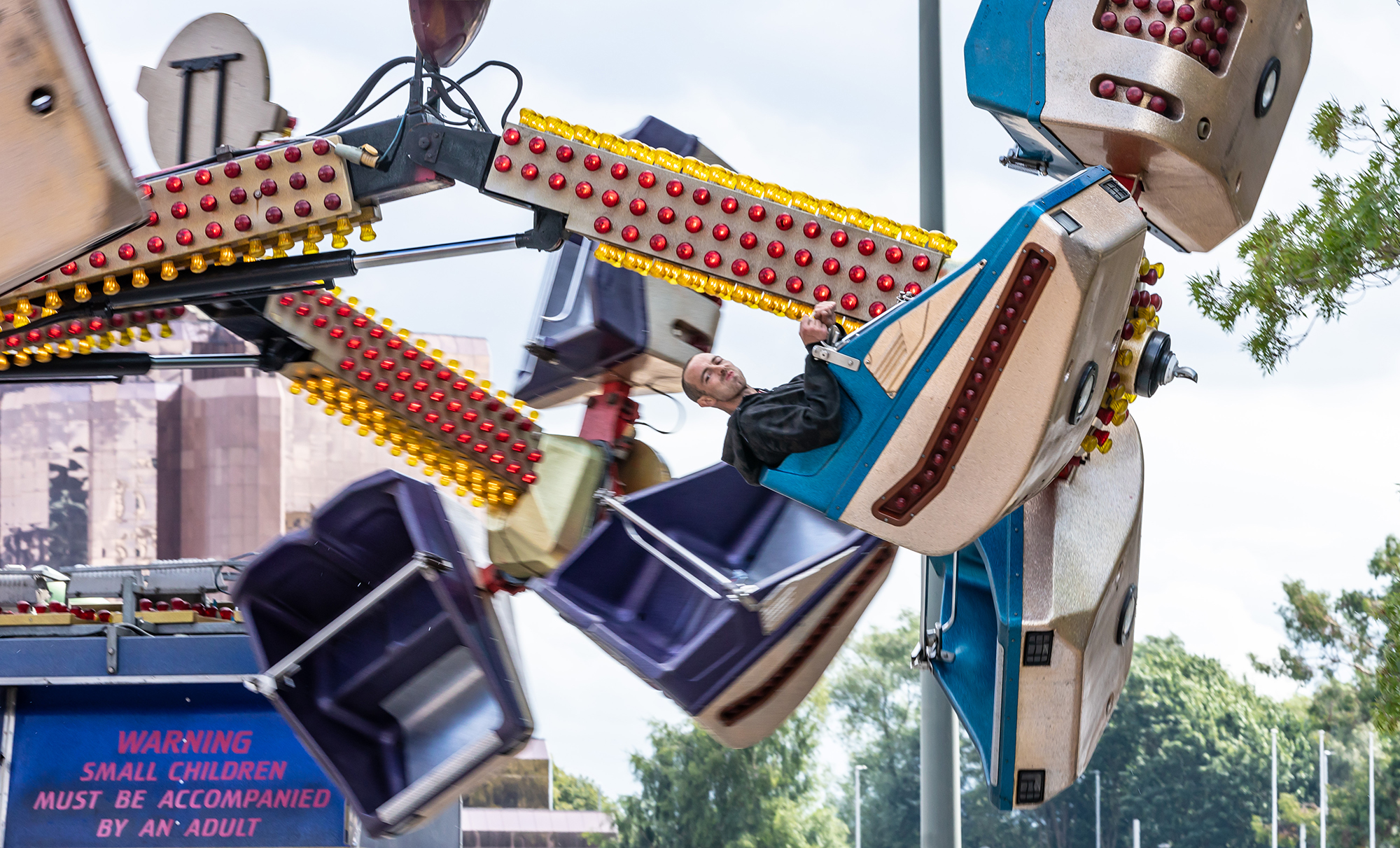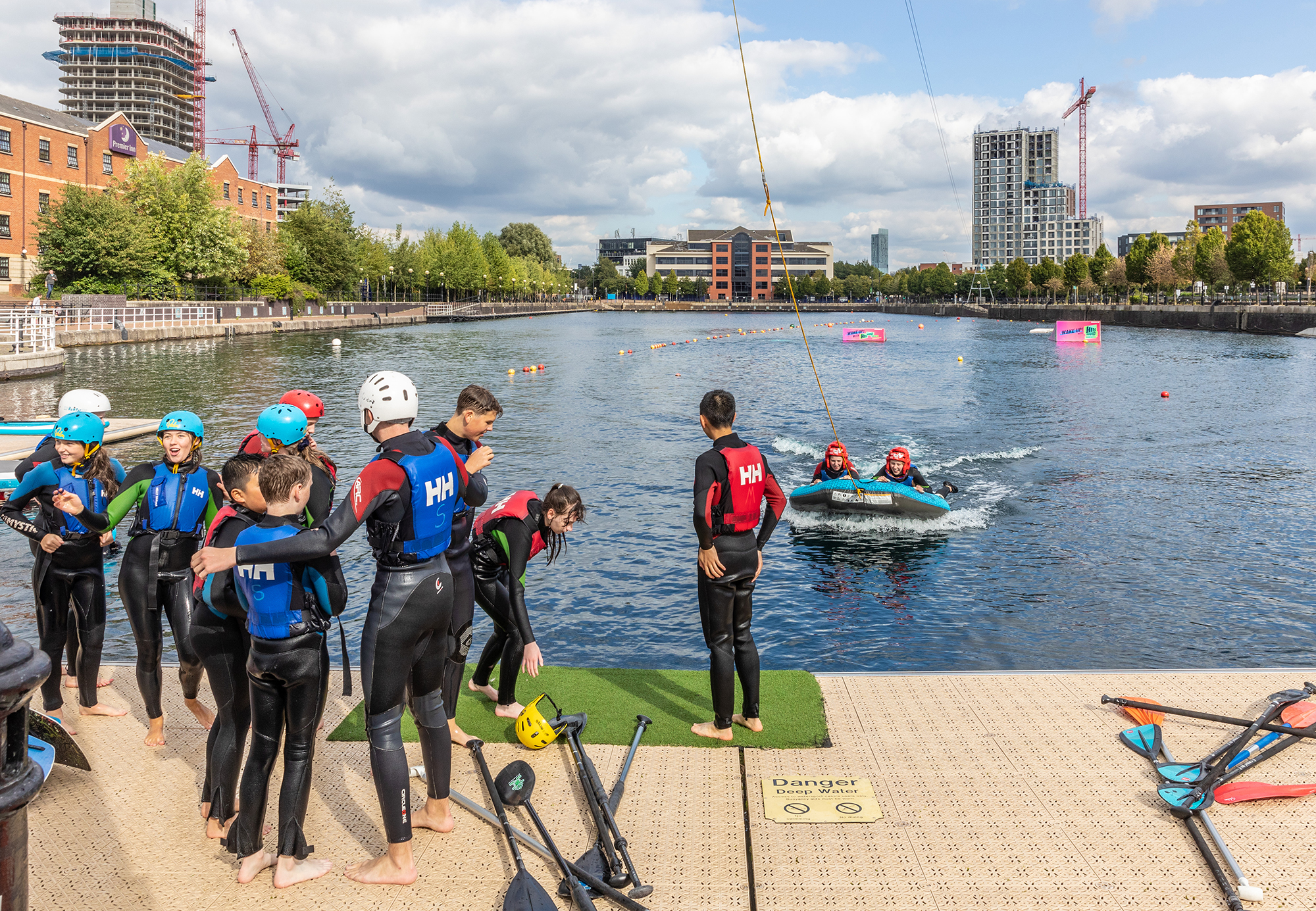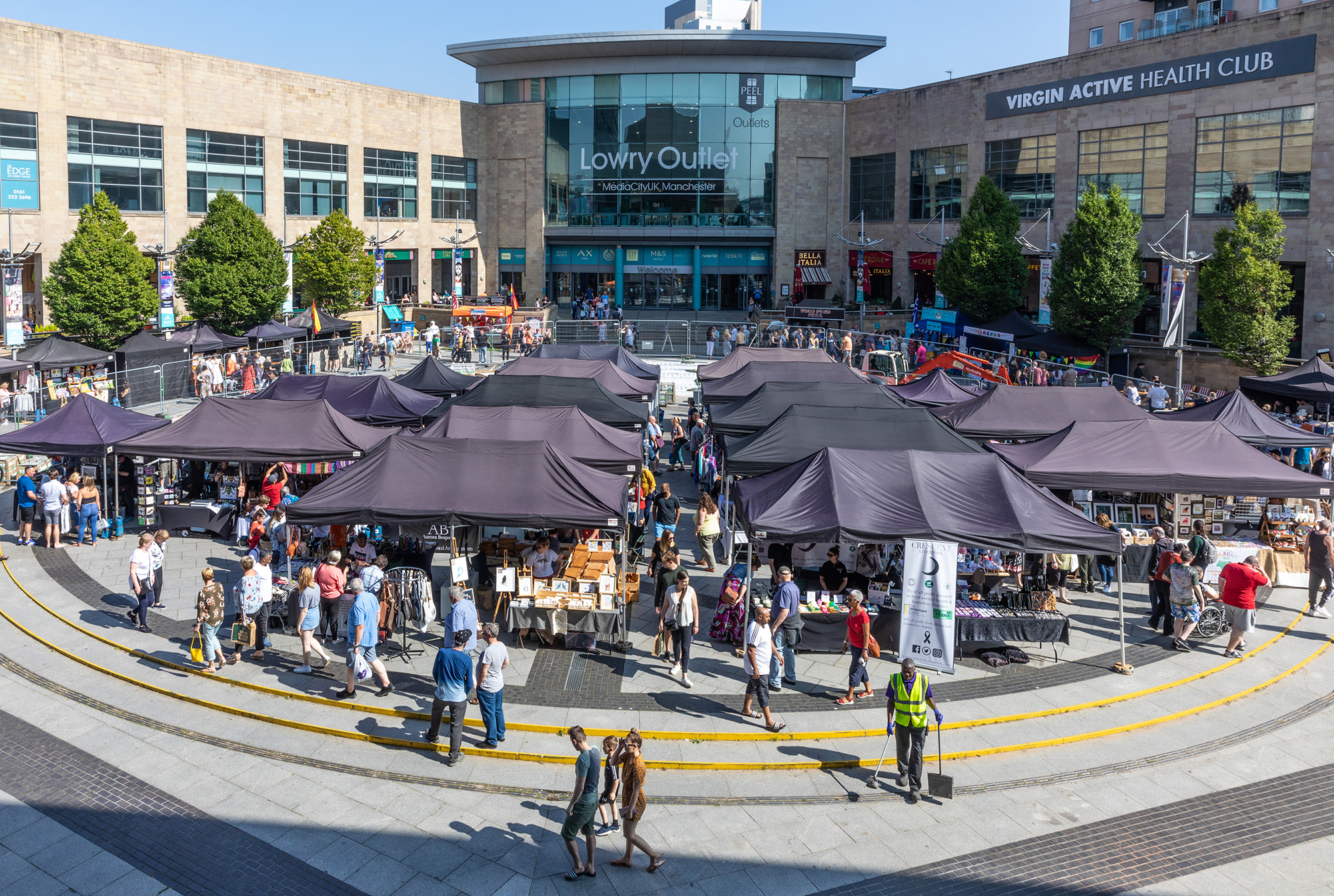Get updates from The Developer straight to your inbox Yes, please!
Placetest: MediaCityUK
Placetest MediaCityUK: What is it like to live and work in Peel’s MediaCityUK and has it brought the promised benefits? Exclusive report by anthropologist Rebecca Toop with photography by John Sturrock
The realisation that the creative class – in this case, media professionals – is an important factor in the regeneration of deprived areas has been influencing policy and development in recent years.
MediaCityUK, developed under a joint venture partnership with Peel L&P and Legal and General Capital, is no exception. Approximately three miles from Manchester city centre and bordered by Eccles, Ordsall, Trafford and Salford, Manchester dockyards remained a brownfield site from their closure in 1982 until the area began its transformation in 2007 into the ‘Media Hub of the North’.
There is no question MediaCityUK’s design was influenced by the need to provide spaces for broadcasters. Besides the state-of-the-art studios that attracted the BBC as an anchor tenant, Peel has designed the open piazza to accommodate live audiences, who come for shows such as The Voice or BBC Sports Personality of the Year.
BBC Breakfast sometimes broadcasts from the piazza and shows such as Blue Peter often film in the gardens when the weather is good. The big screens in the piazza display BBC content on one side, ITV content on the other, with live sports showings quite well attended in good weather – the deckchairs in the gardens are popular on match days. The big screen is also used to promote MediaCityUK as a brand, with the weekly Your MediaCity showcasing the work that is undertaken around the site.
Officially, MediaCityUK contains office blocks that house the BBC, ITV and other companies. It also includes studios, apartments, a hotel, a gym, a small supermarket, The Lowry Outlet mall and The Lowry theatre and gallery complex, as well as multiple cafes and restaurants.
The boundaries of the development vary depending on whom you talk to
But the boundaries of the development vary depending on whom you talk to. People who live and work in MediaCityUK often restrict it to just the side of the development that contains the media: the BBC, ITV, Dock House and so on. They do not include the area across the water that features the outlet mall and gallery.
However, the boundary can also expand to include areas that are not officially part of the development, as many peripheral businesses are attaching the MediaCityUK tag to their premises.
Despite the red lines around the development being fluid in people’s minds, the actual design is inward-looking and innately exclusionary, with the buildings arranged in a semi-circle looking down upon the open spaces.
Peel has created what Dan Sodergren, head of business services at MediaCityUK technology incubator The Landing calls a “billion-dollar backdrop. It’s an astounding piece of real estate, but you have to go across the river to look back at it… I want to bring the investors in by river next time”.
The back of the development varies from the plain and industrial to the downright foreboding – the wall bordering ITV’s studios is blank, high, and dotted with CCTV cameras. “They keep themselves very private over there, for obvious reasons,” says Sodergren.
In fact, the way in which you access MediaCityUK greatly influences your impression of the area. Those who drive in go around the outskirts of the site and will be more aware they have arrived in a private, commercial centre, with expensive multi-storey parking. Arriving by public transport drops you in the heart of the development, among the gardens and open space designed to feel like public space, making MediaCityUK very much a destination “at the end of the line”.
Cycling is a popular method of getting to work in MediaCityUK. It is not uncommon to see a fold-up bike tucked under someone’s desk and there’s a well-used bike storage hub on site.
Although some cycle routes to the site are badly designed, others are well maintained, often taking you along the canals. This makes MediaCityUK feel connected to the surrounding areas.
The rise of Generation Z can be felt in MediaCityUK, with social media an important way for Peel to connect to its audience
The rise of Generation Z can be felt in MediaCityUK, with social media an important way for Peel to connect to its audience. Josie Cahill, head of stakeholder engagement at Peel, says greater focus on social value for that audience means “the lines between work, play and living are blurring a lot more”.
Apartments form the top half of buildings, while studios and offices are on the lower floors. However, this doesn’t seem to have led to as much blurring of the two as envisioned.
Opinions of those on the site ranged from, “I think if I didn’t work here, I’d want to live here,” to, “I think it’s a bit weird to have an apartment right next to the BBC. Imagine waking up in the morning and you’ve got some office man staring at you.”
A contributing factor to people not wanting to live and work in MediaCityUK could be the lack of amenities on site. One worker says: “You can’t run errands in your lunch break. If I want something from a pharmacy, I have to get my wife to pick it up for me as I don’t have time to get there and back during working hours.”
As well as no pharmacy, until early November 2019 there was no bank and there’s no large supermarket within a half-hour walk. The Booths on site – the “Waitrose of the North” or “Tory Tesco” – is not the kind of place for a weekly shop.
“It’s a sort of grab-and-go or topping-up-a-meal-with-nice-things kind of shop.”
There is a gym on site, but membership is £56 a month, compared to £15.99 at a local gym.
Residents’ meetings have made Peel aware of the need for more amenities, so this may be changing with the next phase of development. However, Peel says there are challenges to getting these amenities on site.
In general, the fact that MediaCityUK “feels like a campus” is extolled as a virtue: “There’s a bubble over MediaCity.”
Like a campus, there are sports clubs, triathlons, basketball courts and football pitches that are free to book if you are a resident or work in the buildings. There are also regular freebies, including free magazines available in the buildings, drinks giveaways and ice-cream promotions.
There is certainly the feeling that once you live or work in MediaCityUK, perks open up to you. Whether or not these perks encourage people to buy into the brand, there are many people who work here who consider themselves part of MediaCityUK. They use the pronoun ‘we’ to mean ‘people who work in MediaCityUK’, rather than just people who work at the BBC or ITV.
The social capital that MediaCityUK provides gives people a collective identity. “All the sport comes from up here as well, so when you see sport on BBC News you’re like ‘Oh, that’s us!’”
Onlookers regularly peek into the glass-fronted radio studio when musicians are playing for the morning shows, wanting to be part of the action
As Jane Jacobs theorised in The Death and Life of Great American Cities, there is often in a city “one spot where politicians gather, one stretch of sidewalk where, if you stand there at noon, you will see everybody in town”.
MediaCityUK is built to house the media equivalent on a large scale and there is a sense of being surrounded by media professionals. Snippets of conversation I overhear include the lining up of guests on a radio show. Workers say: “It feels like you’re in the middle of things when you see people filming around you”; and “You do get a few people coming here and hoping to catch a glimpse of a VIP when The Voice is in.”
Onlookers regularly peek into the glass-fronted radio studio when musicians are playing for the morning shows, wanting to be part of the action.
Henrietta Rowlatt, an assistant producer at 7digital and BBC 6 Music, says: “You feel a bit like an animal in a zoo because they are all looking at you.”
There are regular tours around the buildings and into the studios, and it feels like a theme park for the public has been created, with the media hub as the main attraction.
“It’s a tourist destination, ain’t it?” says Rowlatt.
So how does it feel to have people coming to your place of work for recreation?
Jack, a BBC employee, says: “I think it’s quite cool. It’s like, ‘Oh yeah, I work here, and you want to have a little glimpse into my life.’”
Rowlatt adds: “It’s a bit surreal. It’s one of the most surreal places I’ve ever worked. When I come to work on Friday and Saturday, there are all these people running past me, soaking wet, going to jump on an obstacle course, and they look like gladiators. This is a really weird place to work.”
As well as all the opportunities given to the public to feel more involved in the media they consume, there is a strong atmosphere of opportunities being created for those who work or study within MediaCityUK. The Landing “has helped more than 1,600 people either start their own businesses or make their way into work”, according to Sodergren.
Buildings are designed as stepping stones: micro and small businesses can start in The Greenhouse, which offers hot-desking and small office spaces, then move their way up through the Tomorrow building to many of the more well-established towers such as White or Blue. Being on the same site as the BBC and having access to shared facilities, as well as 5G broadband, cannot hurt a business either.
“You’ve got large corporates that want to be associated with and take on board the ideas and creativity of agile, small companies, and equally, small companies want to be able to work and rub shoulders with big corporates”
The University of Salford has a base at the heart of MediaCityUK. Rowlatt says: “It must be amazing for those students to work here. You see them walking around with all their kit, filming, and stuff like that. I mean I studied media but it was in Wolverhampton – it’s not quite the same as actually studying in MediaCity!”
There is also the University Technical College based just next to MediaCityUK (“it’s built there for a reason!”), which aims to pipeline students into The Landing and, from there, get someone like the BBC as a client.
Sodergren says, “There is a huge chasm between the two realities,” but Cahill hopes The Landing can bridge that chasm, feeding into the “wider ecosystem” of MediaCityUK as a whole.
Chris Reay, property director at Peel, says: “You’ve got large corporates that want to be associated with and take on board the ideas and creativity of agile, small companies, and equally, small companies want to be able to work and rub shoulders with big corporates.”
The media industry runs on a high level of social networking, much of which is done outside the workplace. People will regularly hold meetings in the bars and cafes, and Social 7 is MediaCityUK’s version of a business lounge.
Sodergren says: “I think there’s a presumption that a culture of collaboration can instantly exist just because of the potential. What’s exciting about here is that the potential is so huge that I think that would bring everyone close together anyway.”
But rather than just setting up the infrastructure to enable this potential, Peel wants to be seen to take an active role, connecting companies with universities, hospitals and other businesses. Reay says: “We can facilitate that as the manager of the whole environment.”
But what Cahill calls this “long-term custodianship role of the site” has its drawbacks. Despite all the talk of MediaCityUK being an ecosystem, it feels anything but organic. People do sit and read books on the children’s play equipment and occasionally nap on benches; the green space is used for eating lunches and walking dogs. But use of the space is still largely prescribed – MediaCityUK is not the kind of place you would bring a barbecue and you don’t see kids on skateboards. This may be due to the constant security presence, with guards frequently visible riding around on Segways (“Am I in Robocop or something?” asks Rowlatt). It could also be because the outdoor spaces are largely exposed and feel overlooked – there are few tucked-away spaces that give any privacy from the office blocks and studios.
“They seem to not want people there… It seems odd. You can kind of see how it’s designed in a way where it would stop people doing certain stuff”
“They seem to not want people there… It seems odd. You can kind of see how it’s designed in a way where it would stop people doing certain stuff,” says one worker.
Large areas of the development are open space with very little greenery at all, although the council is working on the part of the development it owns, between The Lowry and the Lowry Outlet, as part of a project aptly named ‘Greening the Grey’.
The Lowry Outlet came under Peel’s ownership in 2012. “That is why we bought it – to take control, basically,” says Reay.
However, it still feels very separate, both geographically and in terms of the audience it attracts. Rowlatt says: “The Lowry Outlet feels a bit depressing sometimes. I don’t tend to go there. It’s not great. The broken biscuit chocolate shop is good! Go to that one but ignore the rest.”
But with Peel’s repositioning of the site, it is unclear whether it will improve its offering while appealing to the same demographic that it currently enjoys or homogenise it to fit with the rest of the development.
“You’ve got that little bit of snobbishness… I don’t think they thought Greggs would attract the right sort of people,” says a worker.
Instead of curating your audience, a good development should create an atmosphere. One worker describes this as being where “everyone’s invited and everyone can come and have a play and everyone can enjoy it. Now, OK, maybe not a skate ramp – maybe that’s a bit too street – but certainly there are things that you could do to help that.”
The site’s cultural history as a dockyard is venerated in a sculpture walk
Another cautions: “I think there’s a danger if you just go for a certain demographic, it could become something you don’t want it to be.”
But what do locals think of MediaCityUK? Adam, a local resident, says: “Salford’s reputation has not been great, but [MediaCityUK] has had an impact on the local area. It’s nice to hear that little spots where it used to be really bad – that whole area with the upside-down houses used to not be a nice area to go in – because of this development, there are a lot of professionals who want to live there, which makes the area safe. It gentrifies the area. So from my point of view, I’m thankful that this has happened.”
Attracting a ‘new urban elite’ to improve an area is one thing, but Arie Romein, Jeannette Nijkamp and Jan Jacob Trip argued in Creativity-Led Regeneration: Towards An Evaluation Framework that there should be a move towards strengthening the cultural identity of an area “in a way that the resident population feels at home”.
The site’s cultural history as a dockyard is venerated in a sculpture walk. This features quotes from residents (“Oranges and chocolates were thrown from the Manchester liners coming through the canal” – Pauline Thompson, Dock 9 sculpture); poetry (“Don’t snub your nose at history, the future lives on the past of folks like we” – Centenary Walkway); and mosaics and engravings by local children imagining the places from which exotic goods arrived in Salford.
Sadly, these links to the past are not prominent in the landscape and are not well kept. The quotes, although engraved, are losing their colour, making them difficult to read, and the mosaics are losing their tiles. Perhaps maintaining the links to Salford’s working-class past is no longer a priority.
Peel has done well to attract families to MediaCityUK – the fact that cars are restricted on the site means that children can run around more freely
Despite some locals’ concerns that “areas such as Eccles that need development have this development on their doorstep that’s not for them” and fears that if “it doesn’t look like them” then the development will alienate some people, there is certainly an effort being made to engage with local audiences.
Cahill says: “When the BBC first moved in, there was a sense that clearly this is quite a deprived area where we were building this brilliant shiny new development. The BBC, for every single event or production or show, they always ringfence at least 25% of their tickets to local, Salford postcodes.”
The BBC also runs a ‘Young Ambassadors’ scheme that gets local young people into paid work experience placements. Peel also wanted to include local people and businesses right from the construction stage. Reay says: “When we constructed the BBC buildings, 12% of workers on site were from Salford and 51% from Greater Manchester. We delivered 220 apprenticeships to local people through just that three-year period of construction.”
Peel has done well to attract families to MediaCityUK – the fact that cars are restricted on the site means that children can run around more freely.
Rowlatt says: “You see families coming here and having picnics, all walks of life, everyone just chilling out on the grass, which is really, really lovely to see.”
It also feels very safe. Security on site is largely a “customer service-driven role, mostly because there’s not really too much going on around MediaCity”, according to Josh, a member of MediaCityUK’s security. Even on busy match days, where its proximity to Old Trafford is keenly felt, there has never been any trouble.
Reay says: “We try to use the public realm as much as possible to create a place that the local residents want to use at the weekend or in their spare time.”
Peel has just had what Cahill calls its first “owned event” – the Summer Weekender, featuring music, craft activities, funfair rides and food. She says the company concentrated on accessibility and keeping the cost to attend “as low as humanly possible”, with tickets costing £4 and under-threes getting free entry.
There have been other festival-style events, too, which Adam says “we have never really had locally”. Recently, Architects of Air built on the piazza a 5m-long inflatable structure, ‘Arboria Luminarium’, that was free to enter.
Gabriel Burden, manager at the luminarium, says: “The visitors have been from lots of different backgrounds. It’s a real cross-section, which is great. I thought it would be very media types and officey types. But actually it’s not.”
But diversity is obviously really important, based on where we are, so we produce activity that makes sense to local audiences
But how accessible is it to put on an event in MediaCityUK? There was a feeling among some of the independent organisations and smaller businesses based at MediaCityUK that Peel “charges an extortionate amount of money for putting on events”, to the point where small-to-medium businesses are limited to holding events in the bars and communal office spaces.
Cahill says: “We have an arrangement with the BBC, for example, where they get a certain quota of free space a year, because we want to encourage them [to put on events] and because they’re publicly funded… similarly charities and things.”
But how diverse is Peel willing to be? She says: “It would just need to fit with what our vision and values are for the space… I think if you mix in too many different types of events, people are confused about what the place is about. But diversity is obviously really important, based on where we are, so we produce activity that makes sense to local audiences.”
Peel has just secured a £292.5m loan for the next phase of MediaCityUK’s expansion, the plans for which it is currently drawing up. The company has “smart city ambitions”, according to Cahill, and Sodergren believes MediaCityUK is in an enviable position to achieve these ambitions.
“There’s only one centralised management system, which is very, very rare,” he says, “so it means that smart city stuff can be done very, very rapidly. It’s just sitting it on top of the same infrastructure.”
There is also the expectation that Peel will be able to tap into the “skills pipeline” of tech companies based on the site. “It most probably won’t be the big corporates that will [implement smart initiatives] – it’ll be the smaller start-ups that we hopefully helped create at The Landing.” Sodergren hopes that what is achieved in MediaCityUK will benefit wider society: Salford and beyond.
Another potential focus for the next phase will be capitalising on MediaCityUK’s waterfront position
Another potential focus for the next phase will be capitalising on MediaCityUK’s waterfront position, turning the water into even more of an asset. It currently enables some events to be put on that are outside the norm, such as the Neon night swim, triathlons and dragon-boat competitions (although the latter is not organised by MediaCityUK). River tours can also be taken from the site.
However, there is little sense of life on the water. Birds such as swans and seagulls are frequent visitors, but no nests are visible. There is little greenery on the water’s edge, and no houseboats moor up along this stretch of the canals.
Reay says: “We’ve got some fairly wacky ideas about what we’d like to use [the water] for, on a consumer basis.”
It will be interesting to see if Peel can give the water a life of its own or whether it becomes a branded, commercial asset for MediaCityUK.
The ongoing ‘custodianship’ that Peel has over MediaCityUK has the potential to mean far more can be achieved in the space. Its input has obviously been beneficial for those that work here. It has fostered creative talent, with many of the nation’s best-loved TV shows being produced here. It has actively maintained a network of tech start-ups and big media companies through networking events and opportunities to socialise outside work. Engagement with locals has also been proactive.
However, there may be a need to host a broader range of events and to empower local people by allowing them to use the space less formulaically, in ways with which they are comfortable.
It has been said that MediaCityUK “lacks authenticity” and “looks imported”. Allowing the use of the ‘public realm spaces’ to develop more organically and dynamically can only have a positive impact on this.
If you love what we do, support us
Ask your organisation to become a member, buy tickets to our events or support us on Patreon
Sign up to our newsletter
Get updates from The Developer straight to your inbox
Thanks to our organisation members
© Festival of Place - Tweak Ltd., 124 City Road, London, EC1V 2NX. Tel: 020 3326 7238
